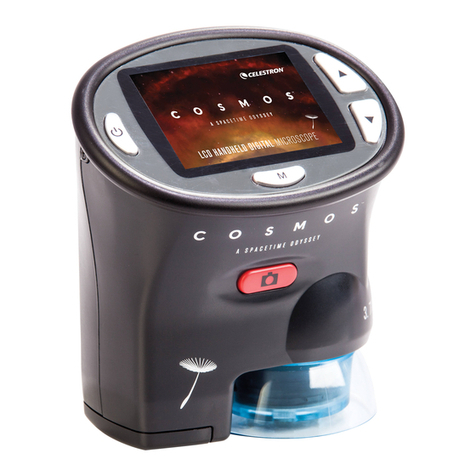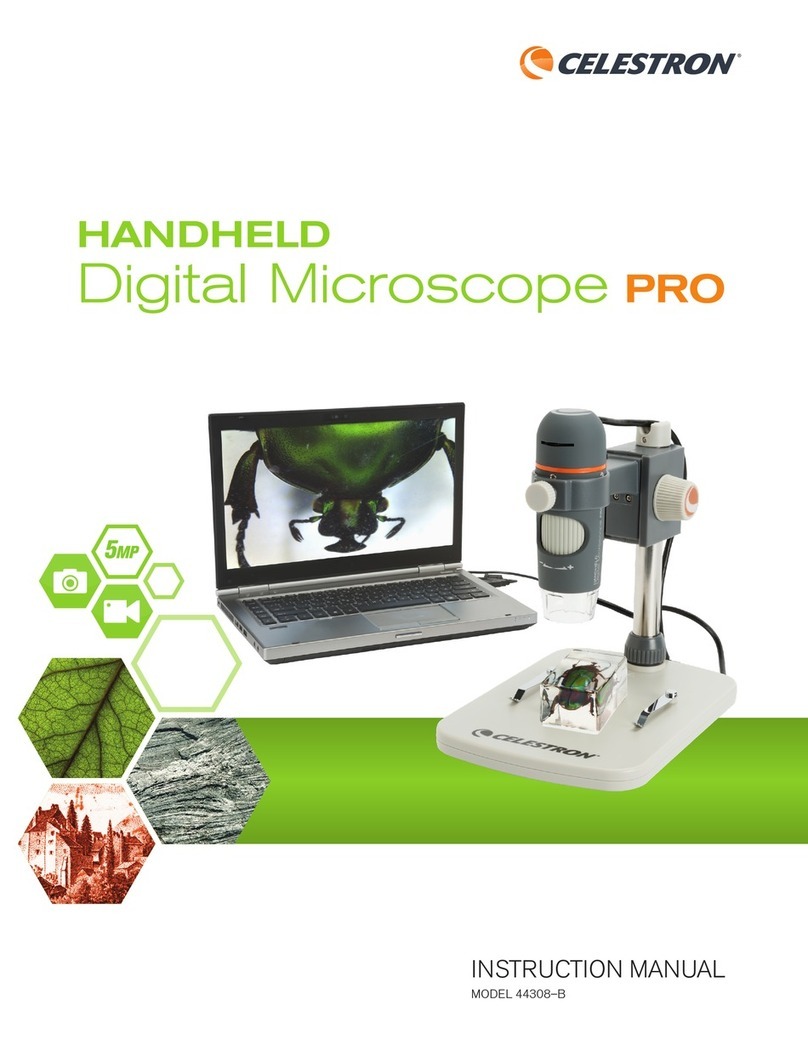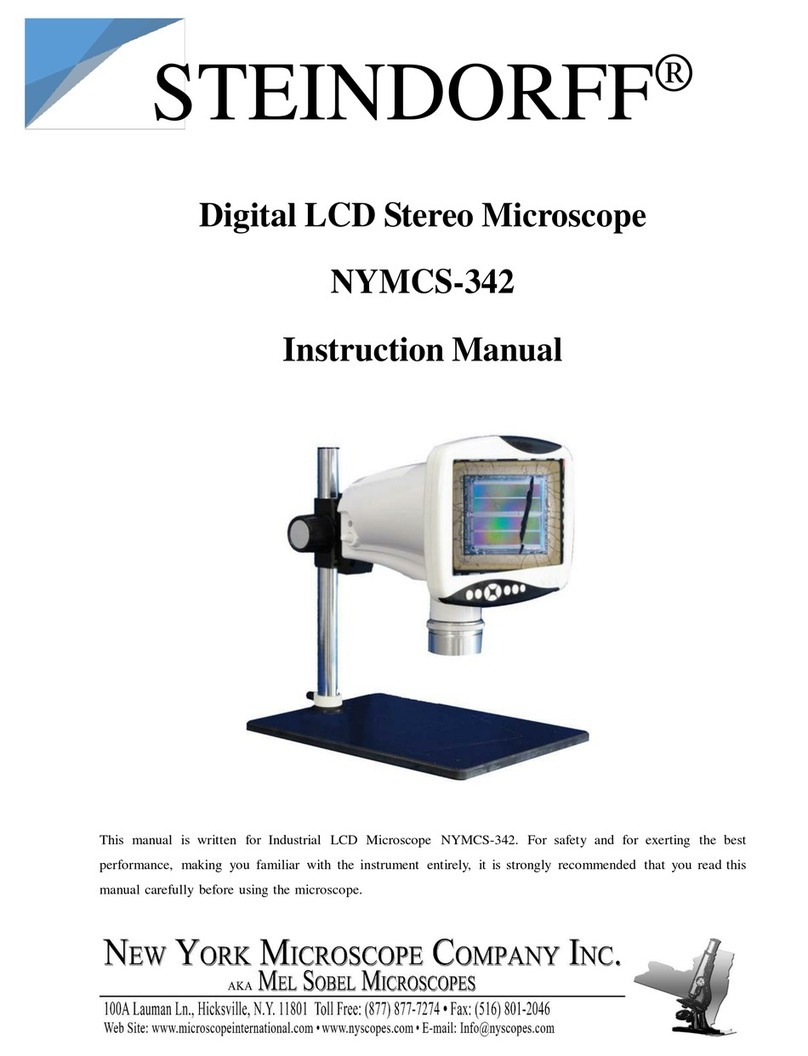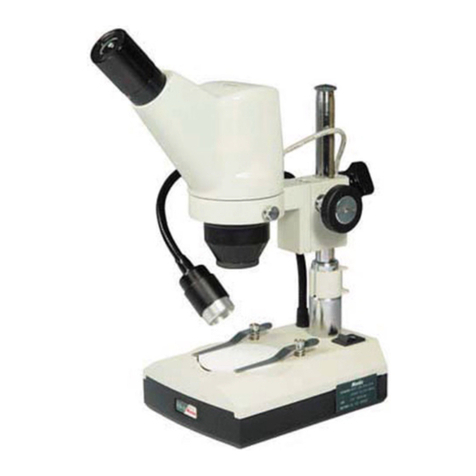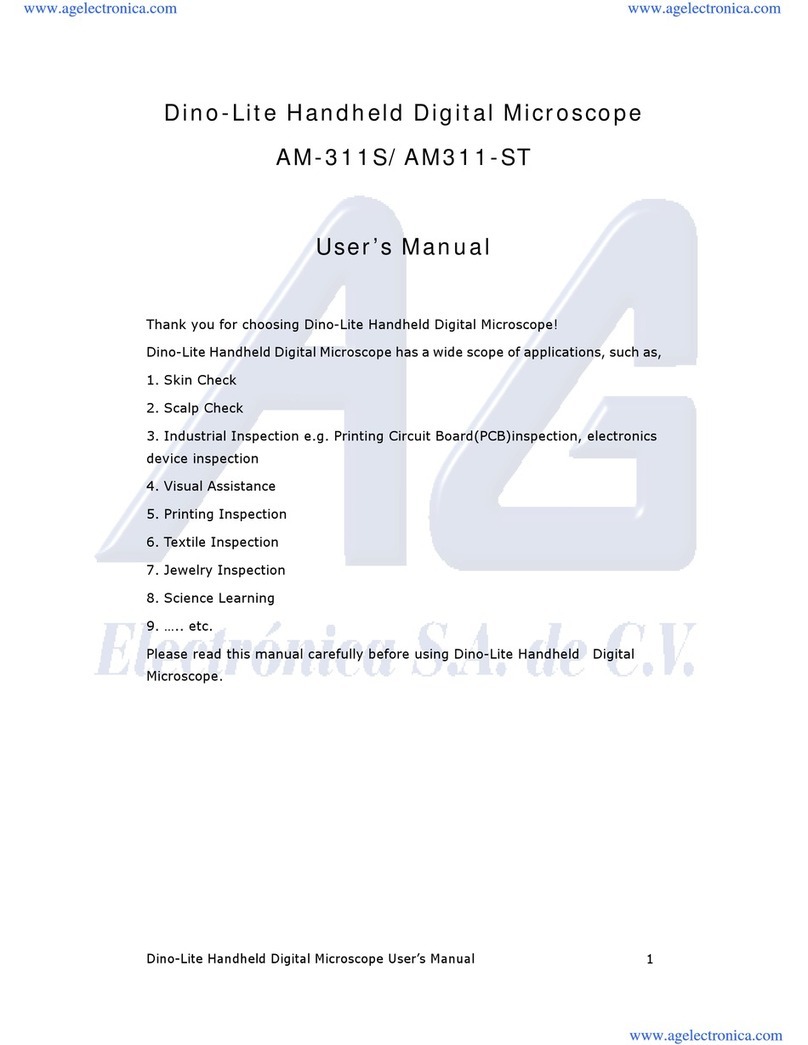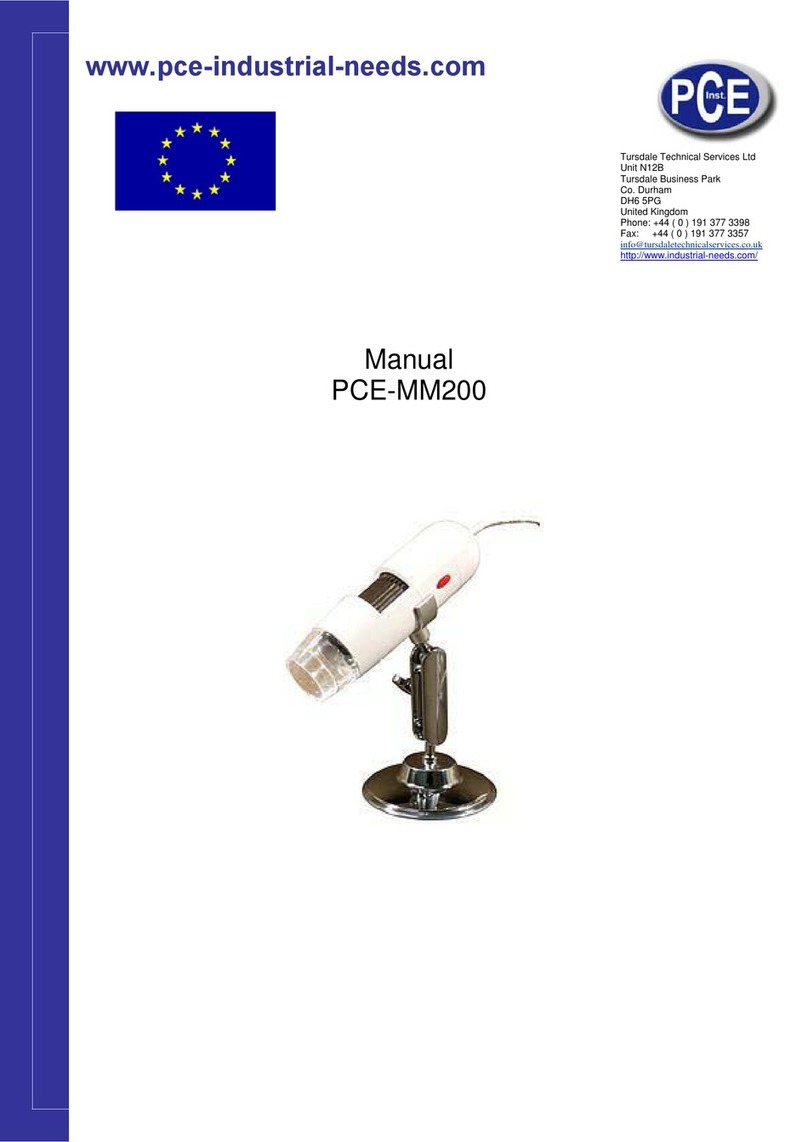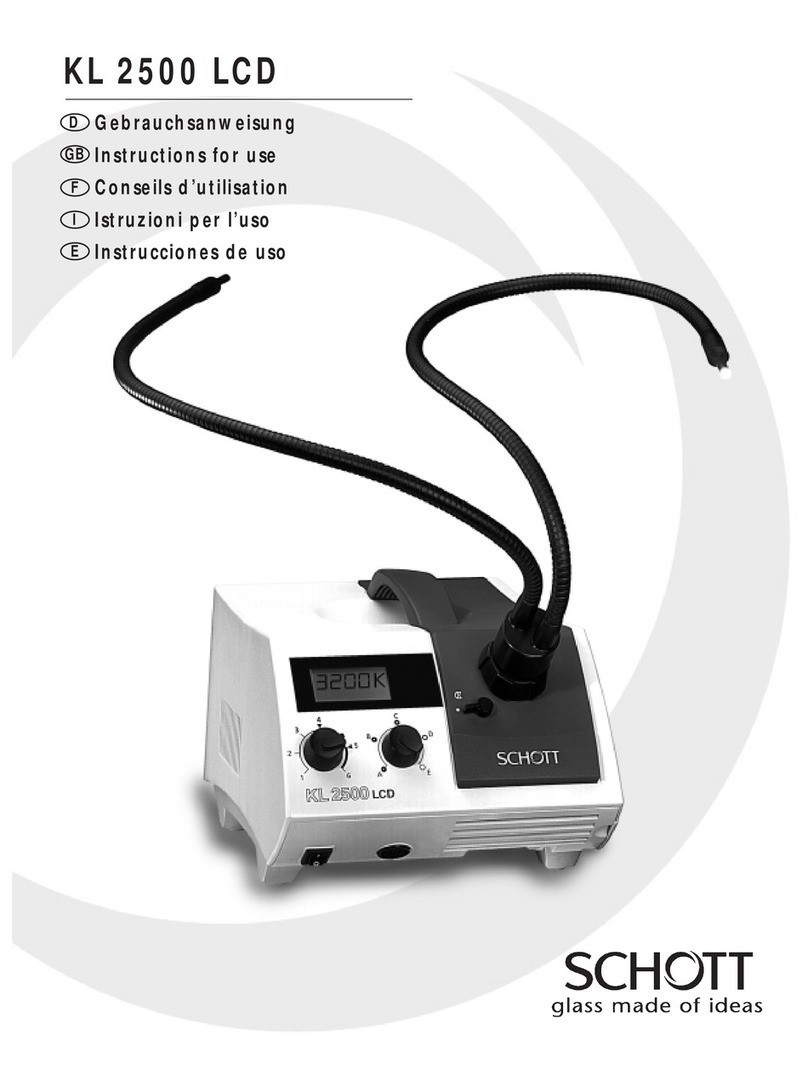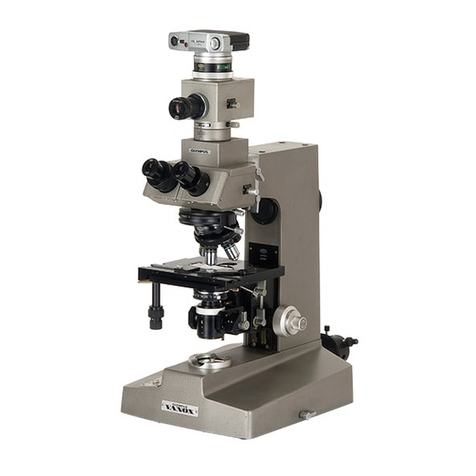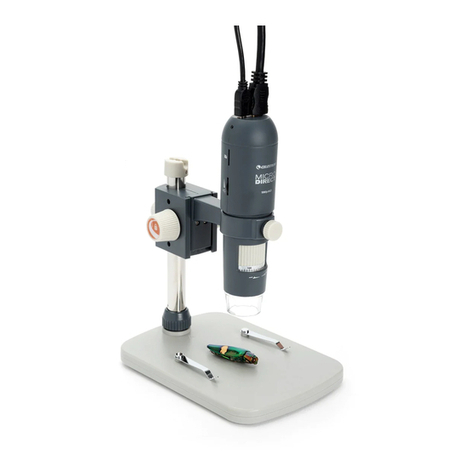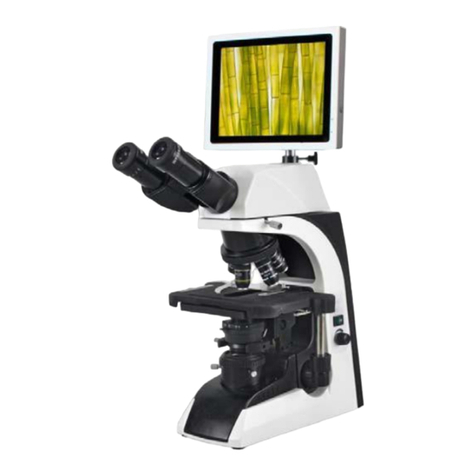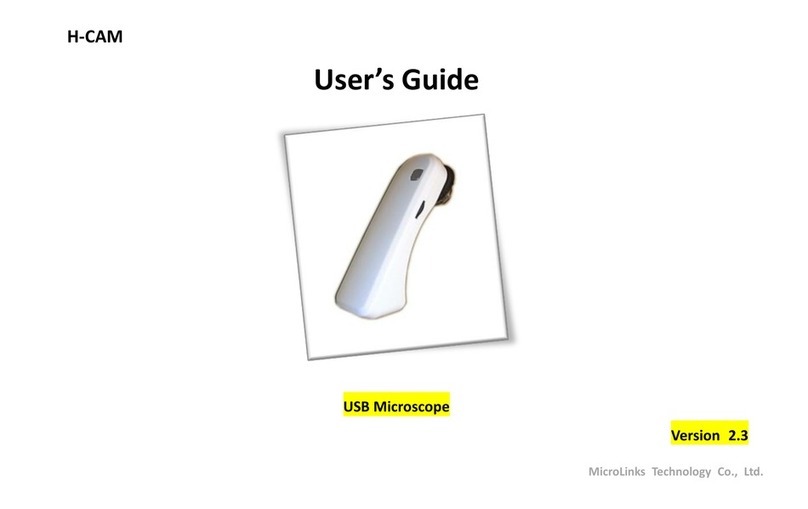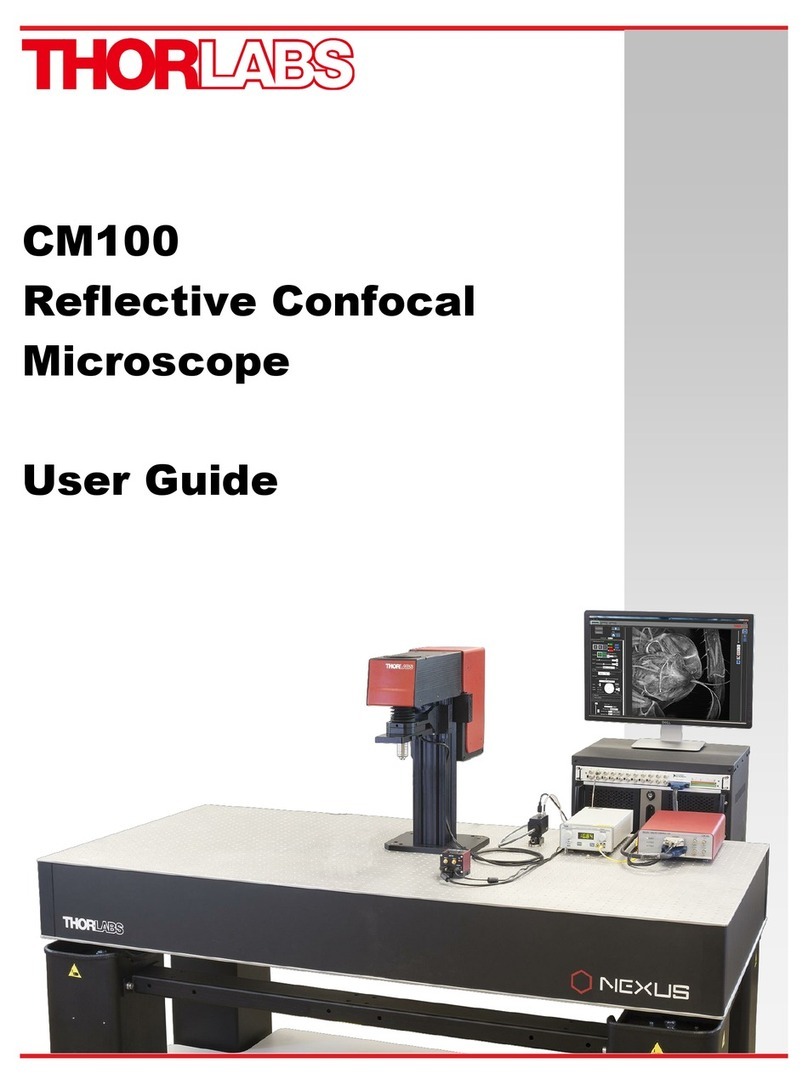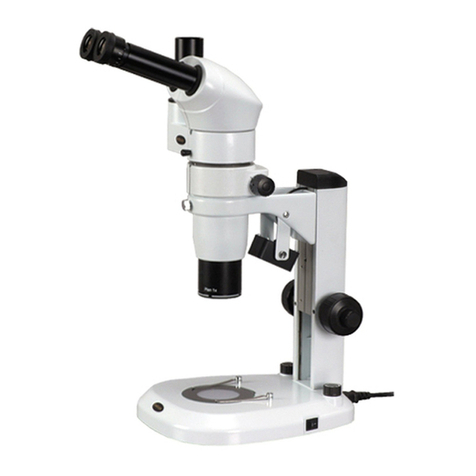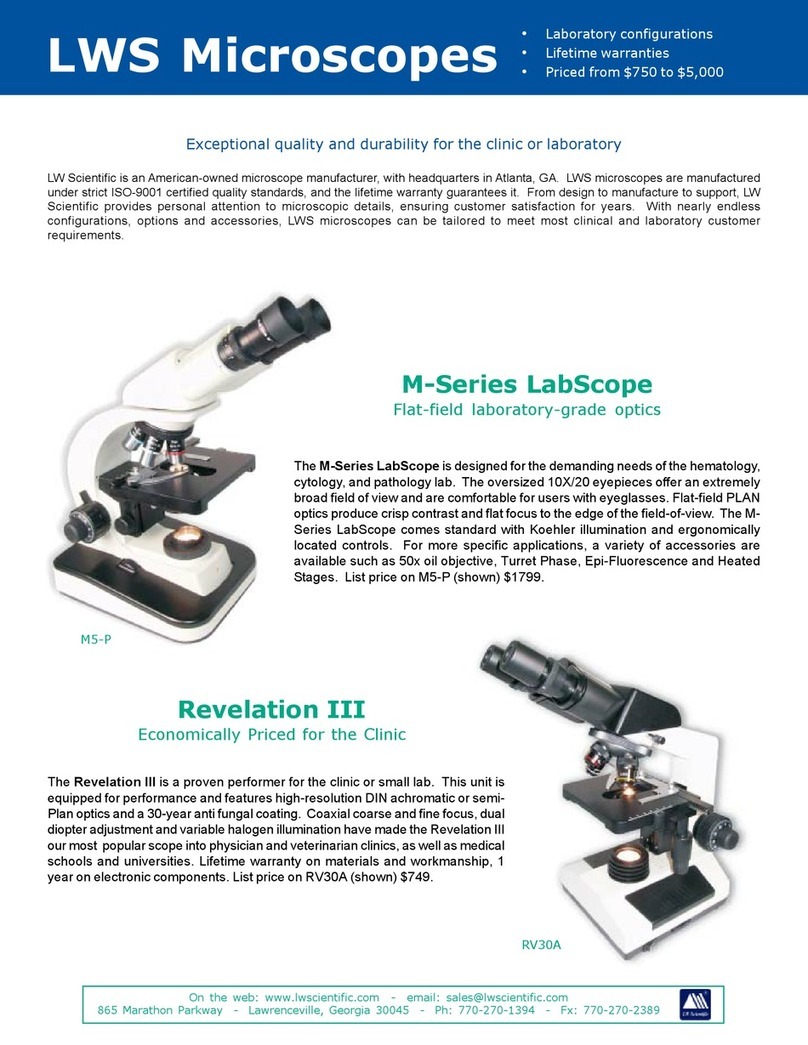BEL Engineering INV-100 Series User manual

Inverted Biological
Microscope
Model
INV-100 series
User Manual
This manual is written for Inversed Biological Microscope INV-100. For safety and for
exerting the best performance, making you familiar withthe instrumententirely, it is
strongly recommended that you readthis manual carefully before using the microscope. For
the further reference, please place this manual in a position where nearby the worktable and
fetched easily.

2/28
Use Notices INV-100
I、Safety Note
Ⅱ、Maintenance
1、Use the gauze to wipe the glass parts gently .If removing the fingerprints and oil stains , slightly
dampen gauze with the xylene or the admixture liquid which comparison is 3:7 of the ethanol and
the aether to wipe.
◐Note: the ethanol and the aether are all very combustible, do not put these chemicals near fire
or the possible electricity spark source such as the electronics equipments open ,close
operation . Use these chemicals in a well ventilated room as far as possible.
2、Don’t use organic solvent to wipe the non-optical elements, If you need to clean, use the neutral
detergent, please.
3、When using, if the microscope is splashed by liquid, cut off the power at once, and wipe up the
moisture.
4、Do not disassemble any parts of the microscope. That will affect the function or decline the
performance of the microscope.
5、If haven’t mounted the objective , please cover the dust cap to prevent the dust and the splashed
liquid of the tissue culture entering the inside.
6、When not using, remember to cover up the microscope with the dust casing. And make sure the
1、Do not keep the instrument in a direct sunlight,
high temperature or humidity, dusty and easy
shaking environment. Make sure the stage is plane,
horizontal and stable enough.
2、When moving the microscope, please hold up the
instrument with one hand on the lower side of the
eyepiece tube ①, and the other hand on the
illumination bracket②.(figure1)
3、If the bacterium solution or the water splash to the
stage, objective or viewing tube, pull out the power
cord at once, and wipe up the microscope.
Otherwise, the instrument will be damaged.
4、When working, the lamp house on the top of the
arm③(figure1) will become very hot, be sure there
have enough room around the lamp house
(especially the top) for cool.
5、Before replacing the lamp bulb or fuse, turn the
main switch on the “O”(off) position, then cut off
the power. If the lamp is on, or soon after it has
been turned off, it is hot and will cause serious
burns, please do the replacement after it cool down
completely.
◐Specified: the halogen lamp 6V30W
6、Earth this instrument to prevent the lightning strike.
7、Use the supplied power cord, please.
Figure 2
Figure 1
1
2
3
4

3/28
lamp cools down enough before you do so.
ⅢSafety Symbol
Symbol
Meaning
The surface is very hot, not touch by your hands
Before using ,please read the instruction carefully, improper operation will result in bodily
injure or instruction malfunction.
The main switch on
The main switch off

4/28
1. Components INV-100
Figure 1
Phase contrast slider
Objective
Lamp house
Microscope base
Stage (fixed)
Objective turret (Nosepiece)
(fixed)
Stage lengthen splint
Glass stage
Quintuple
turret
Trinocular viewing tube
(fixed)
4X
10X(PH)
20X(PH)
40X
Ocular (eyepiece)
Condenser
Stage inserted plate
Illumination bracket

5/28
2.Installation INV-100
2.1 Installing diagram
The following figure shows the installation sequence of the components. The number in the figure
shows the installation steps.
Before installing, be sure every components is clean, do not score any parts or glass surface.
Keep well with the supplied hexagon wrench. When changing the components, you will need it
again.
Figure 2
①
②
③
②
⑧
⑥
④
⑦
⑨
⑤
Lamp
dffff
ffuse
滤色片座
colorfi
lter
玻璃载物台
物镜
目镜
电源线
机械式移动尺
载物台接长托板
Lamp house
Microscope base
Stage lengthen splint
Mechanical ruler
Power cord
Objectiv
e
Glass stage
Ocular(eyepiece)
Filter holder
Condenser
illumination unit
Color filter

6/28
INV-100
2.2 Installing steps
Figure 3
2-2-1 Installing and replacing the lamp
(figure3)
Please use the specified halogen Lamp 6V30W.
1. Hold to the bulb ①after you wrap it with
gauze or other protection materials, then depress
the plugs②into the jack③on the lamp house,
ensure the filament and the bolt④are in a same
level.
2. Replacing the lamp when using or soon
after
When using, or soon after it is turned off, the
lamp, the lamp house and nearby parts will be
very hot and will cause serious burns. Please turn
the main switch on “O” (off), pull up power
plug, and make sure the bulb, the lamp house
and periphery are all cool. Then, you can do your
replacing.
Please insert the lamp gently, or it will be damaged
by excessive extrusion.
Do not touch the Halogen bulb with your hands.
It will shorten the service life or cause it to burst.
If you leave fingerprints on the surface carelessly,
clean it with a dry soft cloth.。
Figure 4
Figure 5
3
2
1
4
1
2
3
1
3
5
6
4
2
4

7/28
2-2-2 Installing the condenser illumination unit(figure 4)
1. Insert the condenser illumination unit①into the bracket②gently, according the figure showed in
the left.
2. Turn the condenser illumination unit at clockwise about 90°, let the “AS”mark of filter
holder③facing forwards, and keep the screw of condenser illumination unit and the hole of the holder
in line, then screw down the bolt in the hole with the supplied hexagon spanner.
3. Insert aviatic BNC connector plugs④into aviatic BNC connector jack⑤.
2-2-3 Installing the lamp house (figure 5)
Keep the BNC connector plugs①and the lamp house pin②in line, and keep the
bolt③and the condenser jack④in line, too. Then push the lamp house into the
illumination unit gently until they are against.

8/28
INV-100
Figure 7
Figure 6
Figure 8
2-2-4 Installing the objective(Fig. 6 and
Fig.7)
1. Turning the coarse fusing knob①like the figure
shows till the nosepiece get to its lowest
position.
◐For ensuring the safety of the
instruction on transportation, the nosepiece is
located in the lowest position and the tension
adjustment collar②is adjusted in a
appropriate tight tension while leaving the
factory.
2. Screw the lowest magnification objective on to
the turret from the nearside, then turn the turret
clockwise, mount other objectives according the
magnification sequence of low to high.
◎Mount objective like this way will make the
change of magnification to be very easy in using.
◎It also can install the objective through
the stage opening.
◐Clean the objective regularly, the objective used in
the inversed microscope is very sensitivity about
dust.
◐Do cover all the unused holes with turret dust
caps③, to prevent the dust and contamination
entering inside.
◐When operating, use the low magnification
objective (4X or 10X)to search and focus the
specimen at first, then replace the higher
magnifications if necessary.
◐When replace the objective, slowly turning the
nosepiece until you hear “clicked”, that means
the objective enter into the right position—center
of the light path.
1
3
1
2

9/28
2-2-5
Installing the stage lengthen splint and the mechanical ruler
(
fig. 8
)
◎Stage lengthen splint can be installed in either side of the stage to enlarge the work surface. But you
can’t install the mechanical ruler together.
◎Generally , the mechanical ruler will be installed in the right side for comfortable adjustment.
1. Installing the stage lengthen splint
First, Screw the fixed bolt①on to the splint , then mount it on to the stage from right or left below,
screwing down it until it stay hard.
2. Installing the mechanical ruler
Please install the ruler like the way of the stage splint.

10/28
INV-100
2-2-6 Installing the stage inserted plate(fig.9)
1. When using the glass stage ①, there is no special require,
you just need to place it in a plane.
2. Install the stage inserted plate on to the stage opening.
◎Turn the disk, let the V nick to face user, so the recognition
of the objective will become easier.
2-2-7 Installing the eyepiece(fig.10)
1. Remove the cap of the eyepiece tube①.
2. Insert the eyepiece into tube until they are against.
2-2-8 Installing the color filters (fig. 11)
◐Be sure the color filter cools down completely before
you change them. Take down the filter holder①,
then install the color filters ②you need.
◎Mount the color filter downwards like ③shown, keep it
horizontal through the end, not allow inclined.
◐If the color filter is inclined or not get to the
end④, it will drop possibly.
◎The color filter could be piled on the holder, so you can
install more than one filter according the needs if you can
ensure the whole thickness is less than 11mm.
Figure 9
Figure 10
Figure 11
1
2
1
1
2
3

11/28
figure12
INV-100
Figure 13
2-2-9 Connecting the power cord(fig.12、13
and 14)
◐Do not bring the power cord to bear a
powerful stress. When being bent or
wrapping, the cable and wires will be
broken easily.
1. Turn the main switch①on “O”(off) state
before connecting the power cord.
2. Insert the plugs②into the power jack ③of
the microscope safely.
3. Plug the power cord ④into the power supply
receptacle. Make sure the connection is
well.
4. Insert aviatic BNC connector plugs⑨into aviatic
BNC connector jack⑧.
◐Do use the supplied power cord all the time.
If lost or damaged, select the same
standard cord, please.
◐Connect the power cord correctly, to ensure
the instrument is earthing.
2-2-10 Replacing the fuse(fig.12and 13)
Do remember to turn the main switch①
on the state of “O”(off) before replacing the
fuse, and unplug the power cord. Rotate the
fuse⑥kits out of the holder⑦by the
“--”type screwdriver, replace a new
fuse, then rotate back to the holder
again.
◐Fuse rating: 250V,500mA.
figure14
3
2
7
6
8
9
4
5
1

12/28
3. Adjustment INV-100
Figure 15
Diopter ring
Light path selector lever
Light switch
Tension adjustment collar
Main switch
Coarse focus knob
Fine focus knob
Phase contrast slider
Color filter holder
Aperture diaphragm adjust lever
Phase center bolt

13/28
4. Operating the adjustment INV-100
4-1 Microscope base
4-1-1 Turning on the lamp (fig.16)
Connect the power, turn on the main
switch①(shown on the fig.16)which on the bottom
side of the base to “-”(on).
4-1-2Adjusting the brightness (fig.17)
Turning the brightness adjustment knob
clockwise, the voltage raise, and the brightness
strengthen; whereas turning at the contra direction,
the voltage decline, and the brightness weaken.
◎Using the lamp in a low voltage
condition, will prolong the service life.
4-1-3 Adjusting the Tension Adjustment
Collar(fig.18)
◐
The tight tension of the coarse focus knob
②
had
already adjusted before leaving factory.
◎How to adjust the tight tension
Turning the tension adjustment collar ①. while
revolving at the direction which shown by the
arrowhead on the figure, the tight tension of the coarse
focus knob②is increasing;and if at the contra
direction ,the tight tension will decline.
If the nosepiece dropped automatically, or the
specimen defocused soon even you focus with the
fine focus knob③. It means the coarse focus knob
is too loose, you should screw it down at the
direction shown by the arrowhead in the figure18.
Figure 16
Figure 18
Figure 17
1
2
1
3
1

14/28
INV-100
4-2 Stage
4-2-2 Moving the specimen
Turn the knob of the mechanical ruler or use your hands directly to move the specimen to the position
you wanted, please.
4-2-1 Setting the specimen(fig.19and fig.20)
Set the specimen in the center of the stage, please.
◐
to obtain the best observe effect, please
select the containers, such as culture dish and
culture bottle, with the bottom thickness is
1.2mm, and the same thickness is also required
by the object slide when it is laid the specimen.
◎using the Φ35mm culture dish
You can lay aΦ35mm culture dish on the stage
directly by using the standard center board①of the
stage.
◎using the mechanical ruler
1. When using the 96bit or 24bit micro-titration
board, please fasten it tightly by the stage
clips②.
2. When fastening other model boards, please use
the following supplied brackets with
mechanical ruler:
●Terasaki bracket③for Terrasaki board
●Culture dish bracket④for Φ35mm
culture dish
●Object slide bracket⑤for object slide
andΦ54mm culture dish
3. Turning the transverse knob ⑥and lengthways
knob⑦, move the specimen to the required
position. ( Movement Range: 120(width)×78
(Length)mm)
19
20
1
2
3
4
5
6
7

15/28
◐be careful when you replace the objective, please, especially after a short work distance
observation. Not let the objective to touch the stage inserted plate or the culture dish bracket.
INV-100
4-3 the viewing tube
4-3-1 Adjusting the diopter(fig.21)
1. Look into the right ocular by your right eye,
then revolving the coarse focus knob to focus
on the specimen.
2. Then use your left eye to look into the left
ocular. If the image is not sharp, just use the
diopter adjustment ring①to adjust please.
◐There are ±5 diopter in the adjustment
ring. The number which the reticle on the
eyepiece holder pointed is your eye’s diopter
graduation.
4-3-2 Adjusting the interpupillar distance
(fig.22)
When observing with two eyes, hold on the left
and right prism holder, turn around the axis,
adjusting the interpupillar distance until the left and
right fields of view coincide completely.
◐The reticle on the interpupillar distance
indicator③, pointed by the spot “.” ②on the
eyepiece holder, shows the scale of the
interpupillar distance.(fig.21)
The range of the interpupillar distance:
48~75mm。
Figure 21
Figure 22
2
3

16/28
10
Figure 23
1
4-3-3 Switching the light path(fig.23)
◎Pulling out the light path selector lever①by your
thumb, select the light path you needed.
◎when in the binocular observation, pushing in the
lever until you heard a “clicked”.while in
video or photography, pulling out the lever until
it reached the “clicked”position.
Light path
selector
lever
Brightness
proportion
application
Pushing in
the lever
until it
reached the
limit
position
100% used for
binocular
observation
Binocular
observation
Pulling out
the lever
until it
reached the
limit
position
20% used for
binocular
observation,
and 80% used
for video or
photography
Binocular
observation,
television,
and
micrography
or video can
be operated
simultaneous

17/28
INV-100
4-4 Illumination Unit
4-4-1 Using color filters(fig.24)
◎Selecting the appropriate color filters
according your need, it became more
effective to observe or photography the
specimen. Especially, we suggest using
the LBD color filter, which can
compensate more neutral colors.
◎You could pile up a group of color
filters to the filter holder, if you
ensure they are level and the whole
thickness is less than 11mm.
Color
filter
meaning
IF550
Single contrast color filter
(green)
(used for the phase contrast
microscopy)
LBD
Color temperature transit
color filter(blue)
(used for bright field
observation and
microphotography)
Figure 24
Figure 25
1
2
70-80%
30-20%

18/28
4-4-2 using the aperture diaphragm(fig.25)
◎When in the bright field observation, the aperture diaphragm control the numerical
aperture of the illumination system. Only when the numerical aperture of the objective
and the illumination system being matching, you can obtain the higher image resolution
and contrast, and the increased depth of field, too.
●To recognize the aperture diaphragm, you could remove the eyepiece if necessary. ( you
also could insert in the center telescope )then looked into the viewing tube, you might
see a field of view like the figure shown. The proportion could be changed by dialing
the aperture adjustment lever according your need. (①is the image of the aperture
diaphragm , ②is the edge of the objective)
●Generally, when observing the chromatic specimen, you need to set the size of the
condenser aperture diaphragm at 70%~80% of the numerical aperture which marked in the
objective. but if observing the bacterium specimen which not colored, you could turn
the aperture diaphragm lever at the direction of“
”(clockwise).
5.Phase contrast viewing INV-100
5-1 The name of the components
5-1-1 Phase contrast objective(fig.26)
◎the optional magnification of the
phase contrast is :10X、20X。
◎If you want to know how to mount the phase
contrast objective, please see 2-2-4.
You ought to mount it on the turret.
5-1-2 Phase contrast slider(fig.27)
◎phase centering adjustable slider
●The light ring was centered beforehand,
so it needn’t to adjust in the use
process. If the ring is not in the
center, you could adjust by the
centering bolt.
●The 10X/20X light ring ①is worked with
the 10X,20X phase contrast objective,
while the opening②is used for bright
field .
Figure 27
Figure 26
1
2

19/28
INV-100
5-2 The installation and use
5-2-1 Installing the phase contrast
slider(fig.28)
1. Keep the slider①face ( the surface which had
character) up towards, then inserted it into the
illumination system from the right to the left
like the figure showed.
2. Every light ring or opening has its own
located position, so you need to move them
until you heard the “clicked”to ensure the ring
or the opening reache the center of the light
path.
3. When in the phase contrast observation, do
keep the aperture diaphragm adjustment
lever②on the position of “O”(wide opening).
5-2-2 The centering ring(fig.29 and fig.30)
◐Usually you needn’t the operation of
centering. If necessary, please accord
to the following steps:
1. Place the specimen on the stage and
focus it.
2. Take out the eyepiece, replace it with
the CT ( the centering telescope),and
inserted it into the viewing tube
without diopter adjustment.
3. Make sure the matched phase contrast
objective and light ring( in the phase
contrast slider) have been in the center
of the light path.
Figure 28
Figure 29
Figure 30
3
1
2
2
1

20/28
4. Using the CT to look the light ring’s image①and the phase contrast ring’s image②,
if the light ring’s image is not sharp, please shifting the CT’s ocular until you
can see a clear image of the light ring②.
5. Adjusting the bolts of the two centering holes③in the phase contrast slider by the
screwdriver ③until the light ring center and the phase contrast center are coincided.
6. The 10X and the 20X phase contrast objective use the same light ring on the phase contrast
slider. So you need to check the coincidence of the light ring center and the phase
contrast center when changing the objective. If having departure, you ought to center
again.
◐If the light ring is centering incorrectly, you will fail to obtain the best viewing
effect of the microscopy.
◐After removing or replacing a thick specimen, the light ring and the phase contrast
ring are likely to deviate each other, which will result in a decline of the image
contrast. So if happened, please repeat the steps as above.
◐If the container or the cover flip which used to place the specimen is not flat, it
maybe need to repeat the centering steps for obtaining a more contrast effect. Please
center the light ring by the phase contrast objective, according to the sequence of
low to high magnification.
Table of contents
Other BEL Engineering Microscope manuals


